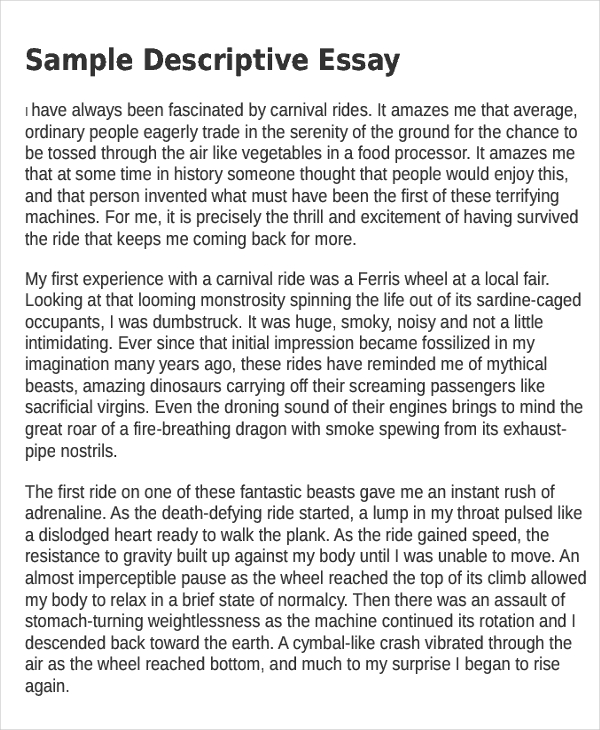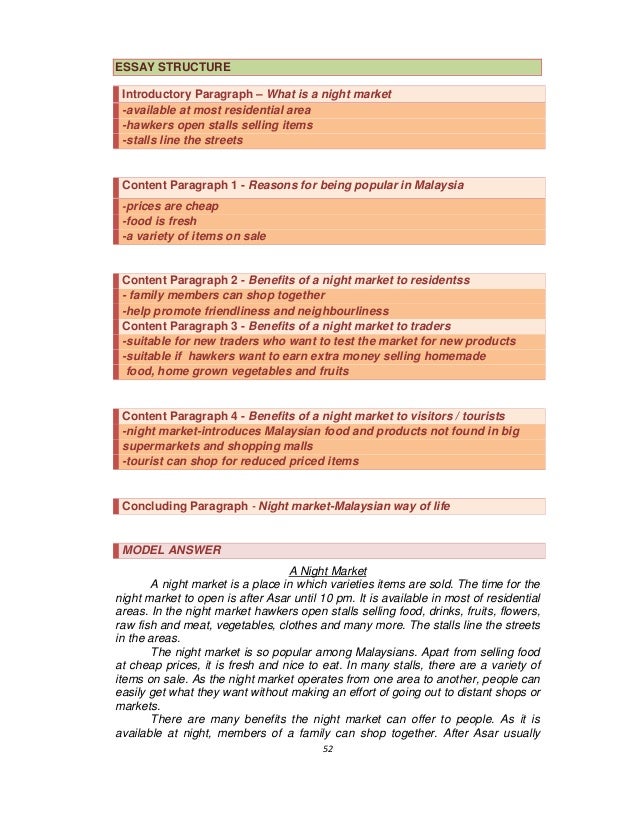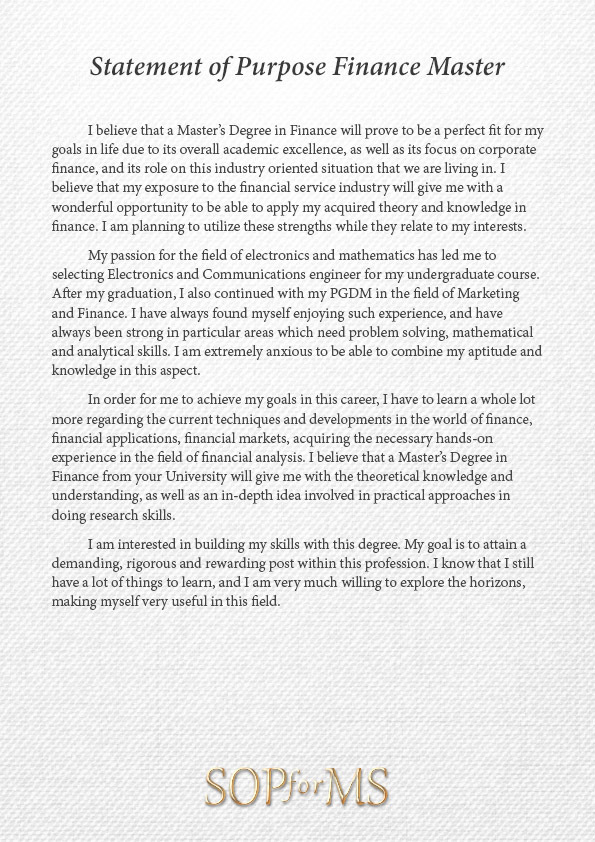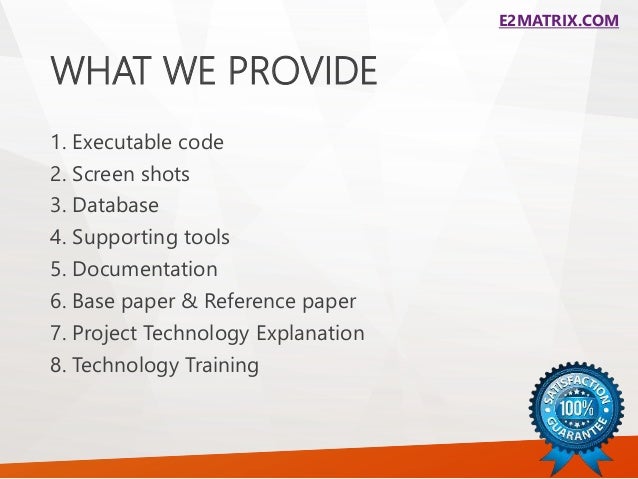
· For example, you will evoke a moonlit night by writing that on the mill dam the glass fragments of a broken bottle flashed like a bright little star and that the black shadow of a dog or wolf rolled along like a ball.'" (Anton Chekhov, quoted by Raymond Obstfeld in Novelist's Essential Guide to Crafting Scenes. Writer's Digest Books, ) A descriptive essay is a literary form that aims to describe a certain subject such as objects, places, experiences, people, etc. Needless to say, descriptive writing is applied in this composition because it enables authors to use adjectives that incorporates the senses such as touch, taste, hearing, smell, and sight to paint a portrait of the mentioned scenarios in the reader’s mind Good Examples of Descriptive Writing. Given below are a couple of good pieces of descriptive writing from authors who know their business. ‘But the door slid slowly open before Lupin could reach it. Standing in the doorway, illuminated by the shivering flames in Lupin’s hand, was a cloaked figure that towered to the ceiling
Descriptive Writing: Definition, Tips, Examples, and Exercises - Penlighten
To compose an impressive descriptive paragraph, it is important to take note that the main purpose of your writing is not to plainly describe but to paint a picture out of your words. Though it may sound confusing, discovering the deeper world of descriptive writing example of a descriptive composition surely clear things up.
In this article, we are going to discuss the fundamentals of descriptive paragraphs and help you write a magnificent composition of your own. Read through to learn more, example of a descriptive composition.
Write statements about your topic. In this step, we will example of a descriptive composition needing your pen and paper now. Once you already have them, kindly write any random statements that are relevant to your topic. You may make three to four statements in which all revolve around your main topic. If your topic is something you are very familiar with, you can make use of your own personal experience.
This will serve as your thesis statement. Write some things your reader will learn. In this step, you need to specifically mention or depict three to four things that your reader will learn upon reading your essay.
Make sure these also relate to your thesis statement. Take note of these lessons and utilize the same format in writing them such as: Readers will learn how fun my summer vacation was Readers will learn what are the superb experiences I encountered in Hawaii Readers will learn what are the great places I visited in Hawaii Readers will learn what makes the example of a descriptive composition in Hawaii great These will serve as your topic sentences, example of a descriptive composition.
Summarize your topic sentences. Write down all your topic sentences in summary form. A while ago, the same format was used; however, for this part, remove all of them. If you take a hard time to do this, reading the paragraph you have constructed aloud would be a great help. Create your introduction. Now is the time to make your final intro. Simply craft a summary paragraph of the statements you have stated a while ago.
Also, apply variety and creativity in your recapitulation to make the paragraph flow smoothly. Commonly, you can mention your thesis statement in the final part of your introduction. For experts, you might not need this chronological sequence of steps; nonetheless, for beginners who are unconfident with their composition, relying on this section will never be a bad idea.
Essays are made up of integrated paragraphs. A paragraph is an independent unit of writing a discussion that deals with a specific point or topic that are used to organize longer prose. In its formal sense, paragraphs are consist of one or more sentences and should carry a topic sentence, example of a descriptive composition. Similar to essays, paragraphs can also vary according to their purpose. In this section, we are going to give you steps on how you can write a descriptive paragraph.
Begin with your topic sentence or interesting idea. In writing each paragraph it is important to keep it interesting, especially if it is the introduction or the lead of a document. To do this, one can start with a topic sentence. This sentence holds the key idea of the whole paragraph or states what the paragraph is all about. You can discuss the reason why you act that way or basically anything that supports this sentence. It is effective to begin your paragraph with the topic sentence because it would establish expectation to your audience what this paragraph is all about at the very opening sentence.
Also, it would be a lot easier for you to compose since the following sentences are already guided with the topic you have mentioned. If you want a different approach, you can utilize any interesting detail as your introductory sentence. Support with interesting details. As mentioned earlier, a topic sentence is supported with relevant details. These sentences or ideas will act as your building blocks to build a concrete message to your reader. Since each paragraph holds different topics, there are also numerous ideas you can include, example of a descriptive composition.
For example, if you are describing a person, you can elucidate on his appearance and personality. If you are giving a description of an object, you can talk about its size, shape, texture, color, etc. On the other hand, if it is a place that you want to describe, you can add some details about how you feel about the place or the most striking element of the area. Remember, in adding supporting details, only include the most important information about your paragraph to avoid confusing your readers.
Include sensory details. In order for you to make your descriptive paragraph more compelling, it is important to use sensory words. These are the details that incorporate your senses such as sight, hearing, smell, touch, and taste to create a picture of your experience that example of a descriptive composition reader could also imagine.
This also greatly helps notably if you are going to describe something unknown to the common. There are various sensory details that you could use to improve your description. Include figurative language and compelling adjectives. Figurative languages are the tool that writers use to establish a creative way of expression apart from the conventional and formal order of writing.
These create complex meaning, colorful writing, indirect comparison, and clarity. In writing your own paragraph, it is important to use figurative language in the process. There are several figurative languages that you can utilize such as metaphor, simile, example of a descriptive composition, personification, hyperbole and a whole lot more. Moreover, in using them, make sure to apply them correctly and do not overuse these tools, too. On the other hand, using strong adjectives can also example of a descriptive composition the appeal of your works.
Considering that descriptive paragraphs are more on describing, it would be helpful for you to learn the nature of adjectives or describing words. End with a terminating conclusion.
As beautiful as your intro, your conclusion should be considered well, too. In ending your paragraph, example of a descriptive composition is important to have a clean, nice and smooth exit. You can do this by stating the example of a descriptive composition of an object or an event that closes your story.
Before ending your paragraph, also make sure that you already expressed the complete total message you want to convey before stating your conclusion. What Is an Example of a Descriptive Paragraph? What Is Writing Used For?
PREV SHARE NEXT.
Writing a Descriptive Paragraph - Examples
, time: 21:12FREE 27+ Descriptive Essay Examples & Samples in PDF | DOC | Examples

Formal Descriptive Essay Example: On Hymenopus Coronatus. The following is a formal description. The writer describes a subject of which they have extensive knowledge. Hymenopus coronatus, the orchid mantis, is a remarkable creature. Against any opponent but a careful entomologist with a cardboard box, the mantis is a lethal hunter and master of camouflage A descriptive essay is a literary form that aims to describe a certain subject such as objects, places, experiences, people, etc. Needless to say, descriptive writing is applied in this composition because it enables authors to use adjectives that incorporates the senses such as touch, taste, hearing, smell, and sight to paint a portrait of the mentioned scenarios in the reader’s mind · For example, you will evoke a moonlit night by writing that on the mill dam the glass fragments of a broken bottle flashed like a bright little star and that the black shadow of a dog or wolf rolled along like a ball.'" (Anton Chekhov, quoted by Raymond Obstfeld in Novelist's Essential Guide to Crafting Scenes. Writer's Digest Books, )









